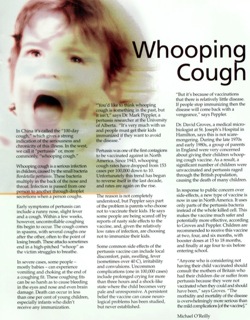Northern Ontario communications consultants
 Services
sample: Scientific
article
Services
sample: Scientific
article
Whooping Cough
Second Wind health journal, 2004
In China it’s called the “100-day cough.” Here in the west it goes by its scientific name “pertussis” or as it is best known, “whooping cough.”
 Whatever one calls it, the disease is real and is a growing threat here
in North America.
Whatever one calls it, the disease is real and is a growing threat here
in North America.
“You’d like to think whooping cough is something in the past, but it isn’t,” explains Dr. Mark Peppler, a medical microbiologist and pertussis researcher at the University of Alberta. “It’s very much with us and people must get their kids immunized if the want to avoid the disease.”
Pertussis is a common diseases children are immunized against at an early age. The disease is caused by the Bordetella pertussis bacteria, a highly-contagious bug that lives in the human respiratory system and is transmitted through the air.
Symptoms can include a runny nose, slight fever and a cough. In a few days, however, uncontrollable coughing fits begin to occur. These attacks sometimes end in a high-pitched “whoop” as the victim struggles to breathe.
In severe cases some people – mostly babies – can experience vomiting, diarrhea, choking and momentary unconsciousness at the end of a coughing fit. These fits can be so harsh as to cause nose bleeds and even brain damage. Death occurs one to two percent of the time.
Pertussis was one of the first contagions to be vaccinated against in North America. Since 1943 whooping cough rates have dropped from 153 cases per 100,000 down to 10. Unfortunately in the last decade this trend has begun to reverse itself, and rates are again on the rise.
The reason is not completely understood, but Peppler says part of the problem are parents who choose not to vaccinate their kids. He says some people are being scared off by reports of nasty side effects to the vaccine, and given the relative low rates of infection, are choosing not to immunize their kids.
“But it’s because of vaccinations that there is relatively little disease. If people stop immunizing then the disease will come back with a vengeance,” he says.
This is not scare-mongering says Dr. David Groves, a medical microbiologist at St. Joseph’s Hospital in Hamilton. He tells of a time in Britain during the 1970s when pertussis raged through the population. Vaccination rates for pertussis had fallen in 1974 following news reports of alleged dangers of the pertussis vaccine. In 1978 an epidemic struck, killing over 100 people.
“Anyone who is considering not having their child vaccinated should consult the mothers of Britain who had their children die or suffer from pertussis because they were not vaccinated when they could and should have been,” says Groves. “The morbidity and mortality of the disease is overwhelmingly more serious than the mild complications [of the vaccine].”
Side effects to the pertussis vaccine can include local irritation, pain and swelling. In very rare cases (one in 100,000 cases) serious reactions can occur. These include unusual screaming, convulsions and seizures. A persistent belief the vaccine can cause neurological problems has been studied, but never established.
In response to public concern over side effects a new type of vaccine is now in use in North America. It uses only parts of the pertussis bacteria instead of the whole killed cell. This makes the vaccine much safer and potentially more effective, according to Groves and Peppler.
-30-